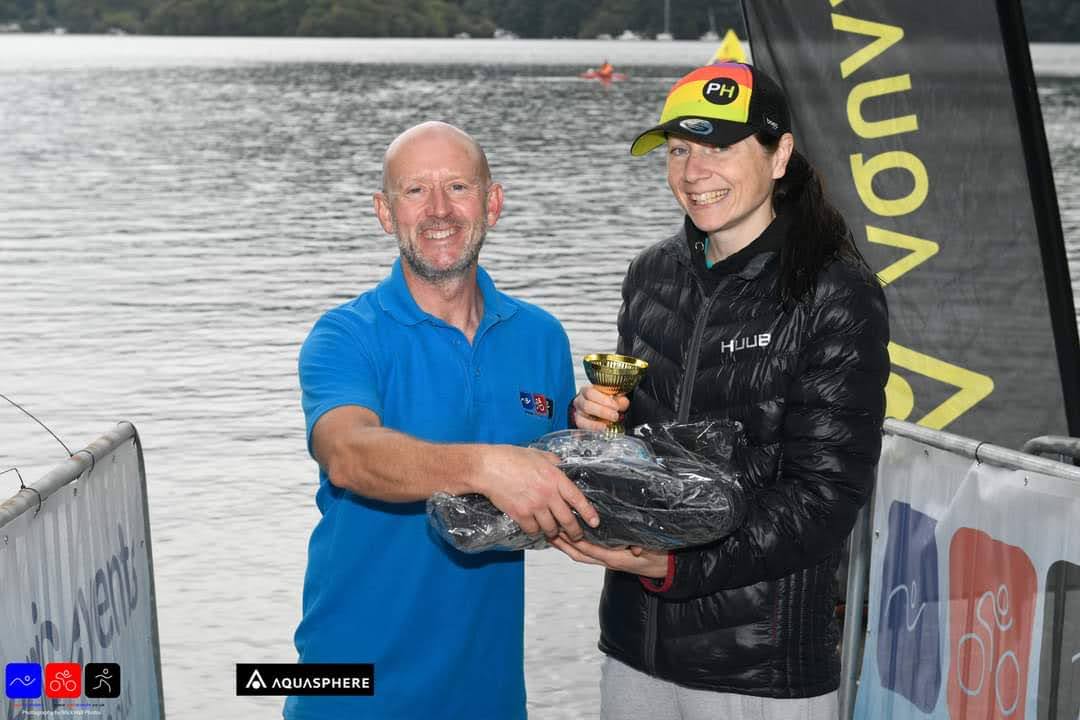As a pro cyclist, Bex Rimmington, collected numerous accolades with UCI Team WNT before tackling triathlon in 2018. A maiden IRONMAN® win (which featured her first ever marathon) was swiftly followed by another full-distance victory at Weymouth and a gold medal at Staffordshire 70.3®.
But Bex's progress took a hit when she was diagnosed with the autoimmune disease Sjogren’s syndrome. It's a condition that doesn’t have a cure but instead the focus is on managing an individual's symptoms.
Typically, onset of symptoms occurs between the ages of 40 and 60, and it’s more common in women than men. It comes with systemic inflammation, extreme fatigue, musculoskeletal pain and, the most common symptom, lack of fluid production. It attacks the exocrine glands in the body, including lacrimal and salivary glands, which produce tears and spit, leading to dry eyes, dry mouth and dry skin.
Some patients elect to have a procedure that blocks the tear ducts to keep their eyes covered with a layer of tears. Others opt for pilocarpine tablets to help produce more tears, use eye drops and ointments or take medications to increase saliva production, among others. For the muscle and joint pain and stiffness, NSAIDs or stronger painkillers are typically recommended, as well as engaging in strength, flexibility and aerobic exercise to maintain mobility.
Bex easily surpasses the exercise prescription in a typical week, though she’s not immune to the symptoms of Sjogren’s that make training and racing a whole different type of challenge nowadays.
The condition has had an impact on how Bex approaches fueling, hydration and recovery...
Fueling
Symptom: dry mouth
Without enough saliva, chewing and swallowing becomes difficult, especially with dry, crumbly food. It can also cause a microbial shift in the mouth, leading to pain, fungal infections and tooth loss, plus dysgeusia (taste changes). Saliva neutralises stomach acid, so it’s common for patients with Sjogren’s to have reflux and heartburn issues. Tight clothing can exacerbate this, as well as caffeine, spicy foods, alcohol, garlic, onion and other trigger foods depending on the person.
For Bex, food choices, especially during training, have had to change because of how dry her mouth gets. Common fuel options like energy bars, rice cakes, nut butters and oat bars are all pretty much off the table for her. The more her intensity ramps up the harder fueling becomes, as each bite takes a while to get down. Gels, especially the more fluid-like Flow Gel, are useful options for getting carb on board. To mitigate flavour fatigue, we discussed adding in apple sauce pouches and high-carb drinks and smoothies.
Symptom: fatigue
While the conversation around other autoimmune diseases may have increased in recent years, Bex notes she hasn’t seen many athletes openly speak about having Sjogren’s.
The one exception is Venus Williams, who has raised some awareness following her diagnosis in 2011. She’s been vocal about the fatigue, shortness of breath and chronic joint pain she has because of it, and notes she focuses on getting in enough fuel as an athlete versus being overly restrictive with trigger foods. This is a key component that Bex and I talked about, as it’s easy to get caught up in what foods she can’t eat. In turn, that can far too quickly lead to underfueling and further restrict performance.
To combat this tendency, Bex is going to make her main focus increasing energy availability. This means working to train her gut to tolerate more carb during sessions to make sure she’s never running lower than she needs to. She’s already starting out feeling like she’s in an energy deficit because of her fatigue levels, so providing more fuel for her body is important. Since she’s noticed some IBS symptoms (not uncommon for Sjogren’s patients), going slowly and incrementally with a gut training protocol is key.
Increasing energy availability also has implications outside of training sessions, and Bex is going to work to up her intake in her day-to-day nutrition practices. This will come from a variety of foods, including increasing the proportion of carbohydrates to promote recovery between hard training sessions, as well as unsaturated fats, which are helpful due to their texture and the fact that fat is the most calorically dense macronutrient (9 calories per gram). Practically, focusing on adding sauces to meals is a simple way to increase moisture and texture of foods, making them easier to swallow, as well as providing additional calories for little food volume. Because textures need to be mostly soft, food temperatures can be varied to keep things from getting too mundane and instead encourage continued intake. In terms of flavours to try, sour hard candy not only provides carbohydrates but also can stimulate saliva production.

Hydration
Symptom: dry mouth
Because Sjogren’s patients often feel like they can’t get enough water, there’s a risk of overhydration, and subsequent bloating, puffiness and swelling. For heavy sweaters and salty sweaters, drinking too much plain water to try and quench thirst has the added risk of hyponatremia (low blood sodium levels).
Interestingly, Bex is on the lower end of sweat sodium concentration (losing 471 mg/L), though she definitely feels dehydrated and thirsty most of the time. She says she and her water bottle are attached at the hip, and she’s noticed a significant positive impact of taking a PH 1500 before bed to mitigate overnight dehydration. During heavy training, she’s rounding up to the PH 1500 strength (even with her 471mg/L sweat sodium concentration) to promote a bit of fluid retention, but not overdoing the total intake. Even though she feels like she could drink more than one litre per hour, her sweat rate isn’t that heavy – so, to prevent overdoing fluid intake, she’s taking small, frequent sips. Further, she’s using the packets instead of tablets to add an extra ~15g of carb to her usual intake.
Recovery
Symptom: fatigue
Fatigue is arguably the hardest symptom to manage as an athlete, and Bex explains that sessions longer than two hours tend to trigger the toughest recovery. She’ll feel it a couple days later and the recovery process can extend into the following couple of weeks. She’s found her 'sweet spot' seems to be taking 2-3 days off training for more rest before she’s ready to go again. If she takes her foot off the gas for too long though, it’s almost as if her body knows it can stop fighting and the fatigue takes over.
As we can all attest to, stress really does make a difference and has a downstream effect on our physical functions. Managing stress, whether that’s through meditation, therapy, community, religion, sleep hygiene, routines, or a combination of things, is worth practising. For those with autoimmune diseases, stress is often a significant contribution to symptoms and requires an extra dose of 'finding your calm' when situations get tricky.

The “Extras”
Bex is incorporating a range of strategies tackling different areas of the disease to give her body the best support possible.
Nutrients
- Frequent blood work to check nutrient status, such as vitamin D (she can’t have sun exposure due to her medication), iron (to prevent further exacerbation of fatigue), and other vitamins and minerals (there’s a risk of possible nutrient malabsorption from reduced saliva)
- Curcumin, the active ingredient in turmeric, for its anti-inflammatory properties. Often used as supplemental intake for patients with rheumatoid arthritis or other systemic inflammation diseases
- Beetroot, as it can increase nitric oxide and promote blood flow and nutrient delivery to working muscles
- Tart cherry, as it delivers antioxidants and may support recovery from exercise
Physical gear
- Physio sessions, including massage, dry needling, cupping to attenuate fatigue and stay on top of muscle aches and pains
- Eyewear: Although Bex hasn’t had the tear duct procedure mentioned above, she does use eye drops hourly and ointment at night. Her right eye specifically gives her the most trouble and affects her ability to see, causing her to turn her head a lot on the bike. If she notices the wind drying out her eyes when she cycles outside, wrap-around sunglasses would be an option to try.
While these tactics aren’t expected to cure or even be game changers, Bex’s situation calls for ticking off the minutiae on top of mastering the basics. Any extra support she can give her body to alleviate excess energy waste and promote optimal functionality is worth a shot. She’s committed to doing whatever she needs to do to take care of herself physically and maintain the lifestyle that she loves.
In talking with Bex and learning her story, it was evident that she’s not just someone with Sjogren’s Syndrome who happens to have athletic goals… She is an athlete who also happens to have Sjogren’s.
Post-race update with Bex: After implementing the fuel and hydration strategies we'd discussed, she was able to train consistently and went on to place third at the RTTC National Team Time Trial Championship!
The plan involved:
- Using PH 1000 packets during training and targeting a higher carb intake through gut training
- Preloading with PH 1500 before bed
- Incorporating PH 500 during her day-to-day hydration
- Being intentional with carbohydrates and energy intake ahead of the race. As Bex said, she's shifted from a "training to fuel" mindset to one that's "fueling to train and compete".
- Carb-rich breakfast of two porridge pots, a banana and coffee, followed by another banana in the final 30 minutes before the start
- Sipping on Carb Only Drink Mix and PH 1500 just before and after the race. "Even though it's a short event, I was taking sips on recovery, because after recent tests, I don't naturally produce any saliva. So anything I can do to help prevent dryness is really helpful for me."
She reported 9 out of 10 energy levels on race day and a perfect 10 for overall race satisfaction.
"If you'd have told me at the beginning of the year I'd race I would never have believed you. So to get on the podium with my team completely blew my mind. We continue to learn and hopefully make progress!"
Most importantly, she's been able to sustain training and support her overall health whilst doing what she loves.
"I'm super happy. Since putting in place the nutrition and hydration strategies and making those small tweaks, I've had my best run yet of health and training. The consultants are over the moon that I've been able to train in between my treatment, as well!"
The bronze medal was the cherry on top.
